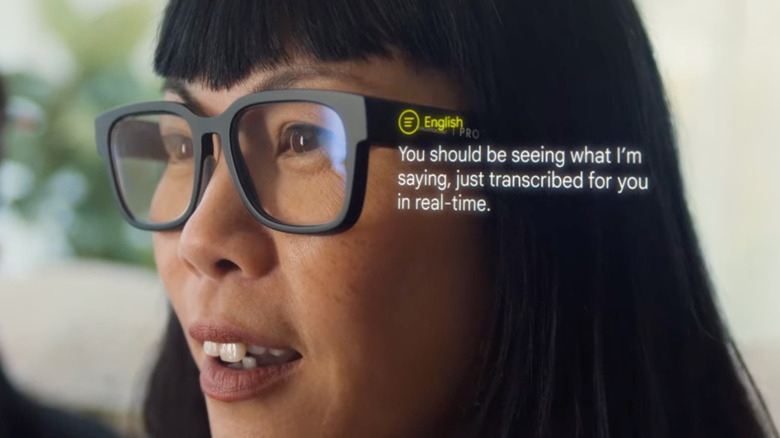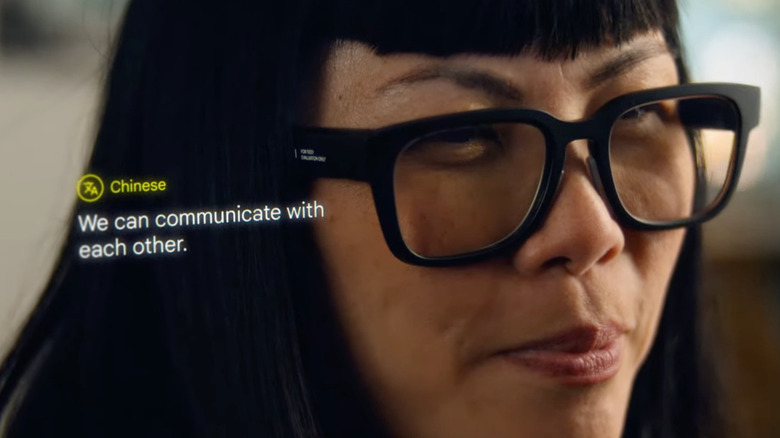Google's AR Glasses Could Finally Put Glass To Rest
It's fair to say Google's big Glass experiment didn't quite pan out, but the search giant hasn't given up on wearables and the potential of augmented reality. At Google I/O 2022, CEO Sundar Pichai revealed one of the latest projects from inside the Google labs, a prototype set of smart glasses that use AR to deliver real-time translation.
The result, Pichai explained, is like subtitles for the real world. Although the Google Translate app allows for speech recognition and translation, and previous Google Pixel Buds earbuds have done translation too, these smart glasses promise to make the process even more seamless. They listen out for speech and then automatically convert it into text in a language the wearer can read.
Obviously, that could be incredibly useful if you're trying to communicate with someone who speaks a different language. Google's demo video, however, also raises another possibility, where a deaf person could wear the smart glasses and rely on them to better communicate with someone who might not know sign language. Instead, the transcription would simply appear as they speak, in their line of sight.
Google quietly spent big money on AR tech
It's one of the most compelling demonstrations of augmented reality technology and smart glasses in general that we've seen in recent years. Certainly, there's no shortage of concepts for AR wearables, including carrying a virtual computer workstation on your face, or immersing yourself into gaming worlds overlaid onto the real world. What Google is suggesting, however, wouldn't be so much obscuring potential interactions, but enhancing them.
Details on the glasses themselves are in short supply right now. The nondescript black frames could almost be mistaken for just a regular set of eyeglasses, in fact, were it not for the "prototype" legend and other text printed on the arms. Google hasn't said what sort of displays it's using, or if they appear in both lenses or just one. It's worth remembering, however, that the search giant acquired California-based startup Raxium: the team there had been working on microLED display technology for use in augmented reality and virtual reality headsets. The deal was believed to be worth around $1 billion.
Try to forget the Glassholes
Glass famously made a skydiving entrance at Google I/O 2012, arguably one of the most memorable keynotes when Sergey Brin live-streamed his landing on San Francisco's Moscone Center after leaping from a blimp overhead. Curiosity in the $1,500 headset soared even higher, with a lengthy waiting list for coveted invitations to purchase "Explorer Edition" early hardware. However, by the time Glass made it into the public, the tide of general opinion was already turning.
The headset infamously garnered outsized quantities of negative press after "Glasshole" wearers were accused of using the built-in camera to sneak photos of people. At the same time, questions about just how useful Glass could be grew in volume. With the processing power of an underwhelming Android phone, and a minimal list of apps, the headset struggled to live up to the pre-launch hype.
Indeed, despite how many billed it, Glass didn't even offer what we now think of as augmented reality: its tiny display was transparent, but didn't attempt to overlay digital information atop the real world. Instead it acted more like a smartwatch screen, floating notifications and voice search results in the corner of wearers' vision. Google eventually retired plans for a consumer version, though still offers an enterprise headset for use in warehouses and similarly controlled settings.
A clearer vision for smart glasses
Even burnt by the Glass debacle, Google hasn't abandoned its vision of high-tech wearables. More recently, Google acquired North, the Canadian startup behind the Focals smart glasses. They distinguished themselves by looking far more like "regular" eyewear, sleekly integrating a single display into one lens. They also bypassed the privacy concerns by leaving out a camera altogether, something this new Google prototype also — perhaps sensibly — adopts.
Google hasn't said when it might be planning to commercialize a set of smart glasses like these, or indeed if it has such plans at all. According to Pichai, the wearable you see here is "one of the early prototypes" that Google has been testing. That certainly implies any release is still some way out.
Still, as a way to clear out some of the lingering bad taste from the Glass days, this new concept already feels a lot more practical. Rather than starting with cool hardware and then trying to figure out what to do with it, as helped undermine the Glass project, these translation smart glasses have a clear purpose in mind, and one which feels close to science-fiction. That makes for a far easier pitch — if and when Google decides to bring them to store shelves.


